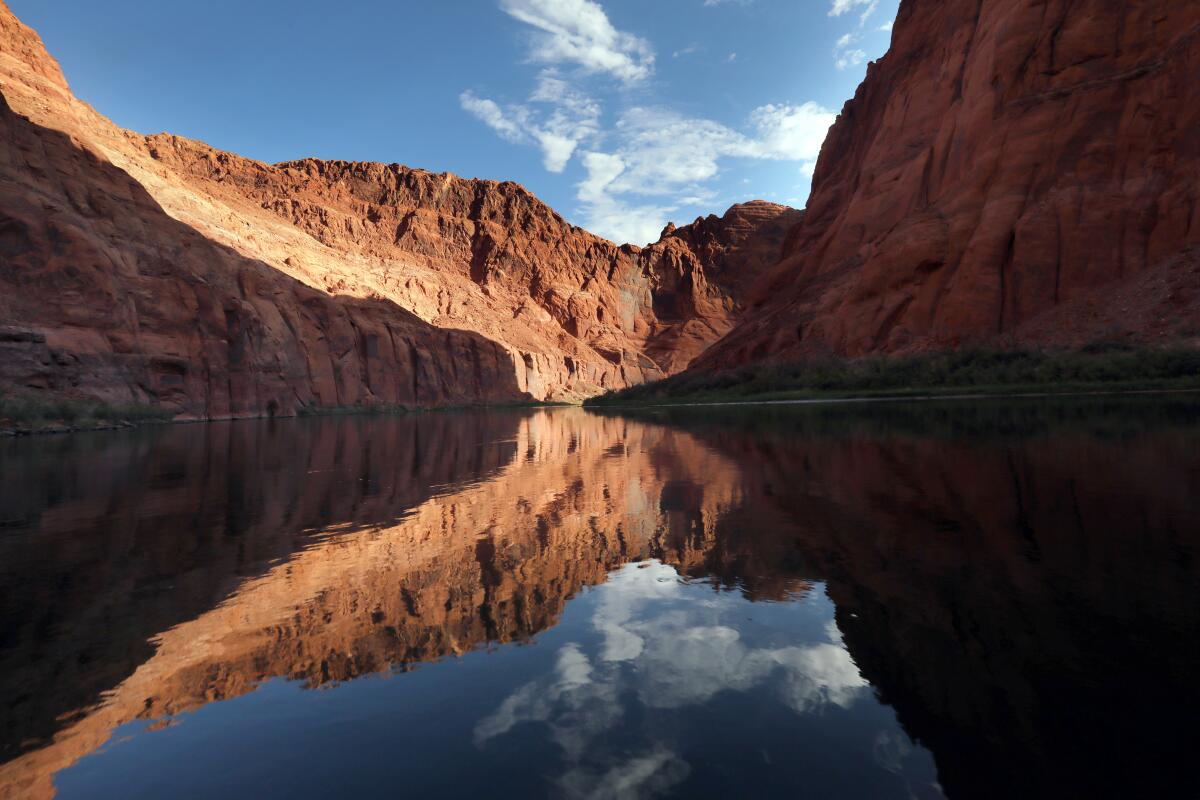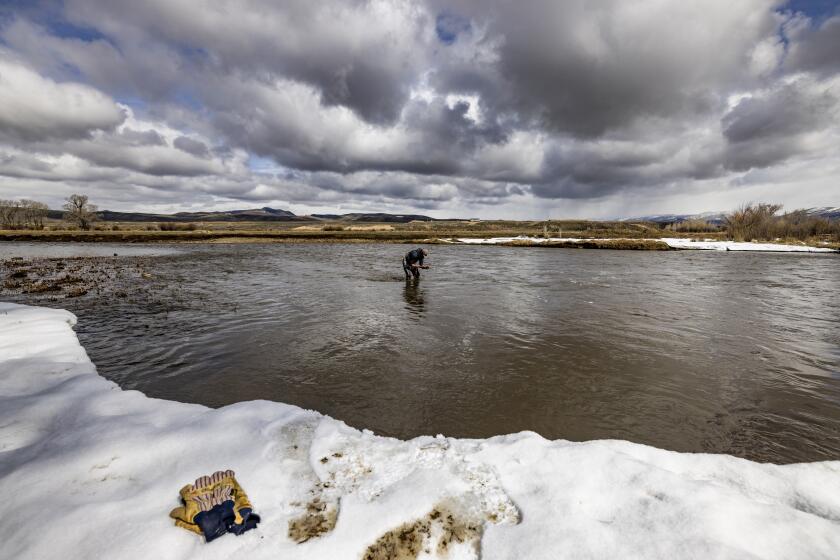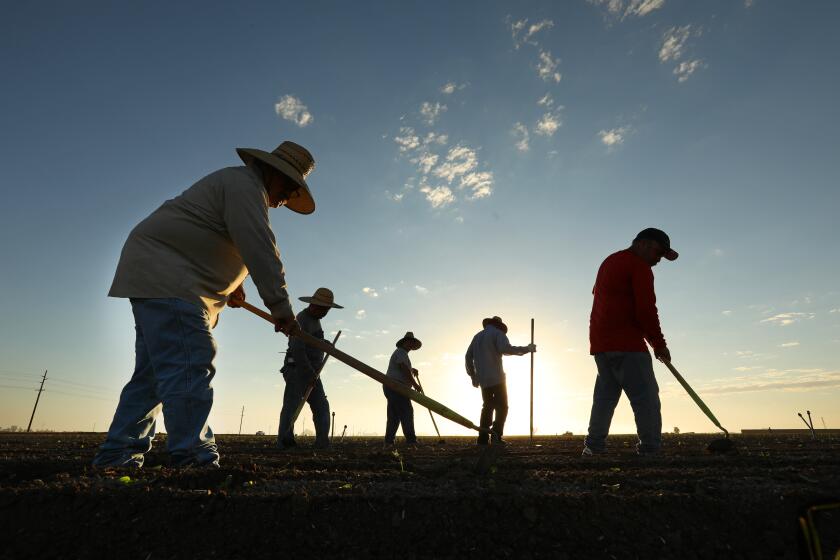States miss deadline to address Colorado River water crisis; pressure builds on California

- Share via
The seven states that depend on the Colorado River have failed to meet a Tuesday deadline for agreeing on a water-use reduction plan, raising the likelihood of more friction as the West grapples with how to manage the shrinking river.
In a bid to influence federal officials after contentious negotiations reached an impasse, six of the seven states submitted a last-minute proposal outlining possible cuts to help prevent reservoirs from falling to dangerously low levels, presenting a unified front while leaving out California, which uses the single largest share of the river.
Arizona, Colorado, Nevada, New Mexico, Utah and Wyoming called their plan a “consensus-based modeling alternative” that could serve as a framework for negotiating a solution. The U.S. Bureau of Reclamation had set an end-of-January deadline for the seven states to reach a consensus. But California officials opposed making evaporation and other water losses in the river’s Lower Basin part of the calculation, as the change would translate to bigger supply cuts for the state.
Colorado River in Crisis is a series of stories, videos and podcasts in which Los Angeles Times journalists travel throughout the river’s watershed, from the headwaters in the Rocky Mountains to the river’s dry delta in Mexico.
In announcing the proposal Monday, Tom Buschatzke, director of the Arizona Department of Water Resources, called it a key step in the “ongoing dialogue” among the seven states “as we continue to seek a collaborative solution to stabilize the Colorado River system.”
John Entsminger, general manager of the Southern Nevada Water Authority, said that “while our goal remains achieving a seven-state agreement, developing and submitting this consensus-based alternative is a positive step forward” as federal officials carry out an expedited review to revise the current rules for dealing with the shortage.
Federal officials told the region’s water managers at a mid-December conference that they would weigh immediate options to protect water levels in depleted reservoirs this year, and that the region must be prepared for the river to permanently yield less water because of climate change.
Lake Mead and Lake Powell, the country’s two largest reservoirs, are now about three-fourths empty. The river, which supplies cities, farming areas and tribal nations from Wyoming to the U.S.-Mexico border, has been pushed to a breaking point by chronic overuse, years of drought and global warming.
Nevada presented a proposal to the federal government last month that, among various measures, included starting to account for the water lost to evaporation from reservoirs and along the river in the three Lower Basin states of California, Arizona and Nevada. But the latest talks in Denver last week ended with the states still at an impasse, said Bart Fisher, president of California’s Palo Verde Irrigation District board.
“It’s become combative and adversarial, rather than collaborative toward a consensus,” Fisher said. “Nobody wants their own ox to be gored. And so it’s become, everyone’s backed into their respective corners, and focused on the largest target, which is California.”
Fisher and other California officials said they were working on a proposal that they planned to submit to the federal government. Farm landowners in the Imperial Valley, who benefit from senior water rights and use the single largest share of the river’s supply, have said they are willing to cut back in exchange for compensation. But they argue that the water-rights priority system should be upheld and respected, and that those with junior water rights, such as Arizona’s cities, should be in line for larger cuts first.
The Colorado River is approaching a breaking point, its over-tapped reservoirs dropping. Years of drying have taken a toll at the river’s source in the Rockies.
“Other states are trying to advantage themselves by urging the federal government to disregard existing law and perform some reallocation of the river that would benefit themselves, as an alternative to collaborating toward a common consensus,” Fisher said.
“In the situation that we face today, of course, the river is overallocated. We must adjust demand to fit supply.”
Federal officials in June called for the seven states to come up with plans to drastically reduce water diversions by 2 million to 4 million acre-feet per year, a reduction of roughly 15% to 25%. But negotiations among the states grew tense and acrimonious and didn’t produce a deal.
In October, the Biden administration announced plans to revise the current rules for dealing with shortages and pursue a new agreement to achieve larger reductions in water use. Interior Department officials have said they will consider alternatives for reductions in their review and may need to significantly reduce the amount of water released from Glen Canyon Dam, where levels have been sinking closer to a point at which the dam could no longer generate power.
So far, four California water districts — the Imperial Irrigation District, Metropolitan Water District of Southern California, Palo Verde Irrigation District and Coachella Valley Water District — have proposed to reduce water use by up to 400,000 acre-feet per year. That would amount to about 9% of the state’s total water allotment from the river for the next four years, through 2026.
But politicians and officials in other states have called for California water agencies to make larger reductions.
Rep. Greg Stanton (D-Arizona) directed strong words at California while urging the Bureau of Reclamation to consider the six-state proposal.
“The depletion of the Colorado River is a slow-moving natural disaster — one that threatens the livelihoods of 40 million people across seven basin states,” Stanton said. “While many of the states have worked together to reach an agreement that works for everyone, California refuses to do its part.”
Stanton urged the federal government to act, saying, “We cannot wait any longer.”
As the federal government pushes states to reduce usage of dwindling Colorado River water, Imperial Valley farmers fear a “worst-case” scenario.
Officials representing the six states said their proposal would help protect water deliveries and hydropower production, and would reduce the risks of reservoirs declining to “dead pool,” a point at which water would no longer flow downstream.
The proposal outlines reductions for Arizona, California and Nevada beyond those the three states have agreed to previously. It calls for accounting for more than 1.5 million acre-feet of water losses, primarily caused by evaporation. The proposal also calls for implementing various efforts in the four Upper Basin states — Colorado, Wyoming, Utah and New Mexico — including “additional voluntary conservation measures.”
This approach “appropriately distributes the burden” across the Colorado River Basin, said Becky Mitchell, director of the Colorado Water Conservation Board.
Brenda Burman, general manager of the Central Arizona Project, said the region needs to move on a “path forward to lay the groundwork for finding durable long-term solutions.”
“We have a lot more to do and this is a critical next step,” Burman said.
Adel Hagekhalil, general manager of the Metropolitan Water District, said California water managers have worked with their counterparts over the last two months to “produce a consensus-based alternative.”
“While we were not able to reach agreement among all seven states on an alternative,” Hagekhalil said, “we were in agreement on the reductions that need to be modeled.”
He said the main stumbling block was “requiring the cuts to be allocated and assigned ... prematurely, prior to the modeling results.”
“California recognized many years ago the impacts that climate change would have on this important water supply and has made significant investments to be more efficient,” he said.
In the Coachella Valley, water continues flowing to lakes and golf courses, even as the Colorado River reaches new lows. Critics say it’s time to limit heavy water use.
The task of reaching an agreement is complicated by the need to manage the currently depleted reservoirs while also preparing to negotiate long-term rules for after 2026, when the guidelines expire, said Elizabeth Koebele, an associate professor of political science at the University of Nevada, Reno.
“I think states haven’t wanted to say, ‘We’ll give up X amount of water,’ and show their cards on that, because my hunch is that that sort of sets the precedent for what they might be able to give up post-2026,” Koebele said. “That makes this so challenging, because we’re trying to kind of put out the fire as we’re also thinking about long-term sustainability.”
Although the Bureau of Reclamation is unlikely to adopt the six-state proposal, which almost certainly would mean litigation from California, Koebele said that doesn’t mean the plan is worthless. She said it’s both strategic and substantive.
“It puts hard numbers on what the other basin states expect California to cut, which is frankly a lot of water right away,” Koebele said. “It puts the ball in California’s court to respond.”











